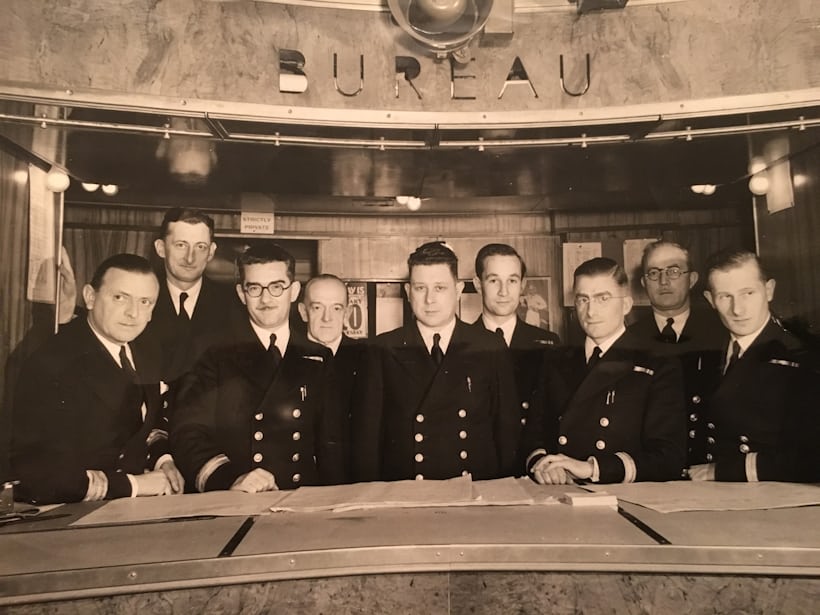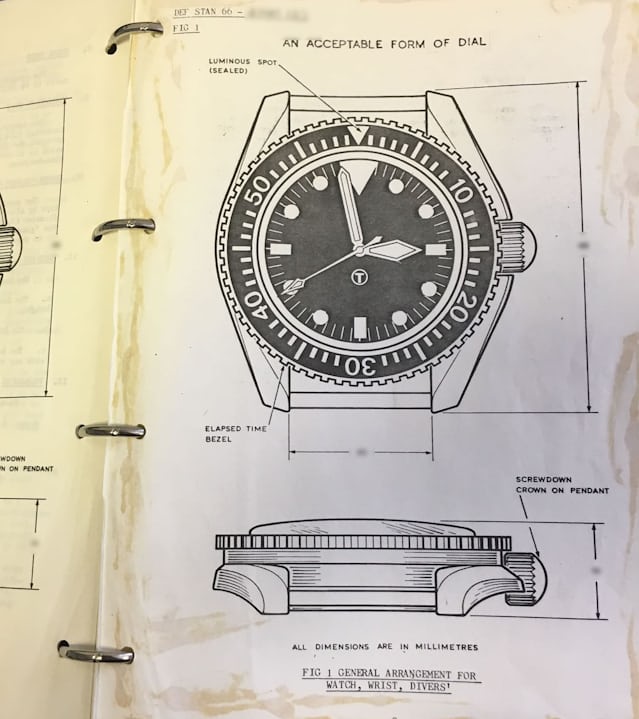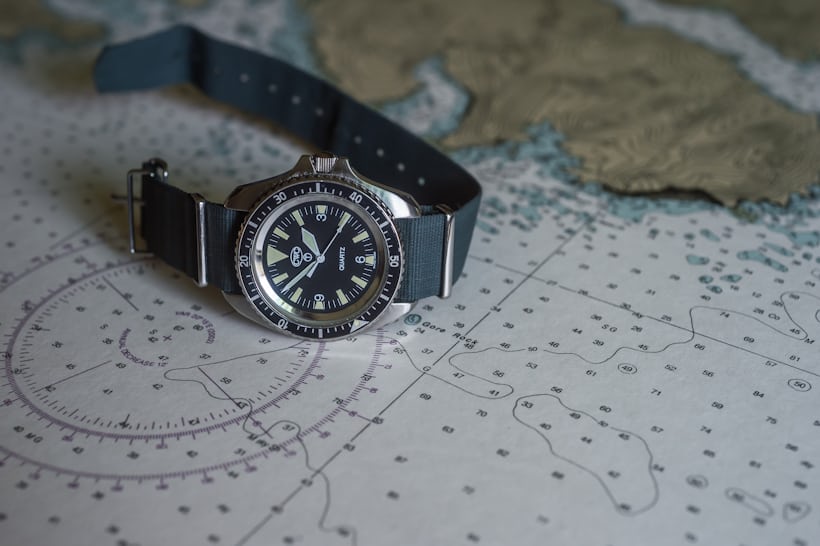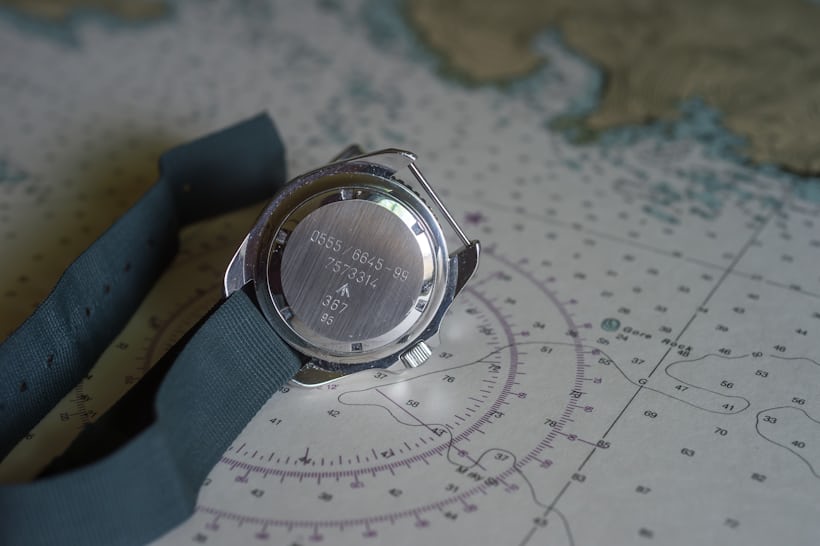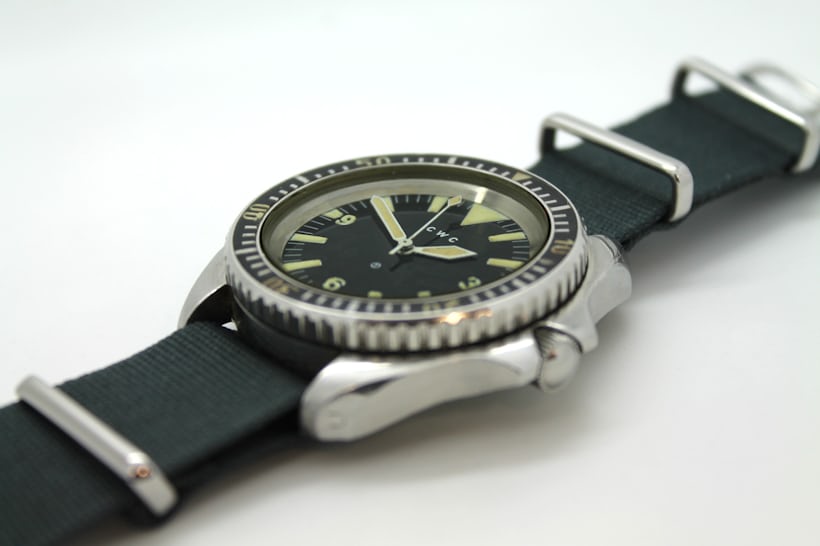Among collectors of vintage military watches, there are a handful of grails worth chasing: one of the rare Dirty Dozen WWW watches, a Royal Air Force–issued IWC Mark XI, or a Heuer Bundeswehr flyback chronograph, amongst a few others. Of course, at the top of the heap sits the legendary MilSub, the Rolex Submariner that was issued to British Royal Navy divers in the 1960s and '70s. These sought-after watches regularly sell for six-figure sums, with a minefield of intimidating nuances and variations through which to wade.
A Rolex MilSub
But there’s another dive watch out there, supplied by a humble British brand – Cabot Watch Company – that actually superseded the Rolex MilSub on the wrists of Royal Navy divers, and its first version, with a self-winding mechanical movement, is far rarer than the Rolex it replaced.
Cabot Watch Company, or CWC, doesn’t have a long, rich history like so many of the big Swiss brands, nor a founder with a melodic name who invented a complication in the 19th century. In fact, it was founded in 1972 by a businessman who saw an opportunity. In the early 1970s, the British Ministry of Defence sourced watches from a number of brands. For divers, there were Omega and Rolex, for pilots, Precista, Newmark, and Hamilton, and for foot soldiers, Smiths and Hamilton. But by 1972, Smiths had stopped making watches and Hamilton, facing the Quartz Crisis, decided that MOD contracts weren’t lucrative enough to continue. Seeing the writing on the wall, Hamilton’s Managing Director for the UK, Ray Mellor, decided to go his own way.
Mellor had served in the Merchant Marine during World War II, on ships transporting troops across the Atlantic. After leaving Hamilton, Mellor was visiting Bristol in the southwest of England, when a name came to him. The famous explorer John Cabot had launched his New World expedition from Bristol in the late 15th century, and Mellor’s penchant for the sea led him to call his new company, “Cabot Watch Company,” after the sea captain. Given his history with Hamilton working on contracts with the MOD, Mellor decided to focus his efforts there and soon CWC watches were being supplied to the British Army, Navy, and Air Force.
CWC founder Ray Mellor can be seen here, fourth from right, during his days in the Merchant Marine. (Photo: courtesy Ray Mellor)
These CWC watches, built to strict specifications set forth by the MOD, looked virtually identical to those that, only a year or two earlier, had “Hamilton” on their dials. They were all made in Switzerland, with workmanlike ETA or Valjoux movements and unadorned steel cases with fixed strap bars. There was the humble General Service watch and the two-register “asymmetrical” pilot’s chronograph, the latter of which has become something of a collectible icon of its own, one of the so-called “Fab Four,” alongside versions from Precista, Hamilton and Newmark.
Archival document showing the MOD specifications for a dive watch. (Photo: Courtesy CWC)
The one contract CWC hadn’t managed to win was for diving watches. The Royal Navy had a long history with Rolex, dating back to the 1950s, and even worked with Omega for a while in the '60s. But by the late '70s, perhaps the higher price of the Submariner made the MOD look elsewhere and, given its good relationship with CWC, the Ministry came calling in 1980.
CWC responded with a tough automatic dive watch of its own, built to the specifications of the MOD (DEF STAN 66-4 [Part 1] Issue 3, for those keeping score), which included a rotating bezel with a fully hashed Bakelite insert, sword hands and a boldly marked dial swathed in tritium lume, a 32mm mineral glass crystal, and fixed strap bars for use with pull-through nylon straps. Inside ticked the sturdy automatic ETA 2783. CWC sourced the rather curvy, beveled 44mm steel case that was first made by MRP S.A., and used by many brands in the early '80s, from Heuer to Chronosport, among many others.
Quartz movements quickly replaced automatic movements in CWC's dive watches.
Of course, being the early '80s, quartz technology was quickly taking firm hold across the watch industry, and it wasn’t long before CWC started fitting all of its watches with battery-powered movements, from its General Service and pilot’s watches to the diver. In fact, the mechanical version of the Royal Navy diver was only supplied to the MOD in 1980 and 1981 (with some possibly trickling into '82), making its run extremely short. To find one now in decent condition can be quite the hunt as well, given their intended use by divers disposing of unexploded ordinance in harbors, inspecting ship hulls and carrying out other military maneuvers. These watches are becoming extremely rare and rather expensive. But for one that is far rarer than a Rolex MilSub, they’re still a relative bargain for an issued military dive watch.
Military issue engravings on the back of a CWC dive watch.
After the migration to quartz movements, CWC continued to supply dive watches to the MOD, even when the Royal Air Force switched to Seiko and Pulsar for its pilot’s chronographs. There have since been several iterations of Royal Navy divers, with PVD black cases and a day/date function for the Special Boat Service starting in the mid-'90s, and others with date or no date. Tritium gave way to LumiNova as well, with the well-known “circle T” emblem on the dial replaced by a circle L. The watches remain sturdy timekeepers, decidedly rugged and purposeful, despite their now almost antique appearance among all the G-Shocks seen on military wrists these days. The quartz versions make a nice alternative to the ubiquitous Seikos and Citizen divers out there, with a dash of military credibility and Swiss-made quality behind them. Word is that the Royal Marines and Special Boat Service still procure these dive watches from CWC.
Ray Mellor never really intended to sell his watches to the general public. He had found his niche with military contracts and business was good. But around 1990, a London-based military gear supplier called Silverman’s, started buying watches directly from CWC to sell. Around this time, Mellor was getting ready to back away from running his company and, given his good relations with Silverman’s, a deal was struck; the latter became owner of the CWC brand. Mellor remained involved as a director but took a back seat from daily operations until 2012, when he finally retired. Now in his 90s, Mellor reportedly still comes to meetings now and then and helps with historical information (like that sourced for this article).
The automatic CWC diver is much rarer than the Rolex MilSub – and a lot less expensive. (Photo: courtesy CWC)
While the later quartz divers are somewhat collectible, especially the issued ones, those rare 1980/81 automatic CWC divers are truly special, representing a transitional period in military dive watches, a “changing of the guard,” so to speak, from Rolex to CWC, and a bridge from mechanical to quartz. The appeal of a Rolex MilSub is that it is essentially a watch from a large luxury brand customized to the specifications of a military unit for a unique purpose. But the appeal of CWC watches is that they were created from the get-go to be nothing more than military instruments, with no pretense or evocative name – Submariner or Seamaster – just a caseback stamped with codes and stock numbers. To those who appreciate the stripped-down utility of dive watches, or military watches in general, the CWC diver might just be the best example.
CWC is planning to reissue that first automatic diver to the exact specifications later this summer and we’ll be sure to cover it when it does. In the meantime, more information on CWC’s current dive watches can be found here.


